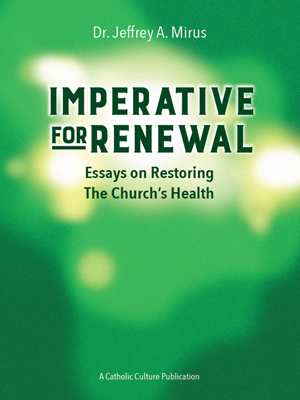the Saint Louis Jesuits, and you
By Diogenes ( articles ) | Oct 11, 2006
Jeffrey Tucker has a thoughtful and balanced review of a book by one Mike Gale titled The St. Louis Jesuits: Thirty Years on the Musica Sacra website. For the benefit of those who partake of the Mozarabic Rite or who have converted to Catholicism within the past half-hour, it may be well to explain that the St. Louis Jesuits are a group of musicians, at one time all Jesuits, who composed and published the chirpy, folk-guitar-based music that has become the standard idiom of Catholic parish liturgy in the English-speaking world. Says Tucker:
Partisans of sacred music might argue that the whole period is best forgotten, the same way the fashion industry would like to forget the leisure suit or patchwork platform shoes for men. But this is not yet possible, for their music is still very much with us at liturgy. Their music continues to dominate contemporary songbooks. Of all the hymns in the mixed-repertoire, mainstream Heritage Missal published by Oregon Catholic Press, 24% are by a member of the St. Louis Jesuits, with 70% written in the style they pioneered. The 2000 edition of Glory & Praise, "the most popular Catholic hymnal ever published," according to OCP, contains 100 songs written by them. One member of the St. Louis Jesuits serves on the US Bishops' Subcommittee on Music, which is working toward naming a common repertoire for parishes.
I admit up front I'm not an unprejudiced judge. I find the SLJ music painful: sugary, trite, rhythmically clunky. The lyrics, though ostensibly biblical in inspiration, have a smarmy mock-modesty about them that is lethal to any attitude of devotion: "What a lucky deity you are, Yahweh, to have such cute and talented disciples as us caroling your praises!" You've all known teenage girls who are in love with the idea of being in love, and stand humming and sighing for hours before the mirror; transpose that woozy self-absorption onto vinyl and you've got Earthen Vessels: The Album.
Though their music be dreck, and the hills turn to dust, professionally the SLJ have always been considerably more modest than their partisans, and have never been bumptious self-promoters. Tucker points out that their popularity was due to forces beyond their control, or even their interest:
To their credit, and despite their recent concertizing on the occasion of their reunion, they avoided giving concerts. They were concerned that their music be used in prayer sessions -- not necessarily in liturgy, at least not initially -- but not as a venue for popular acclaim, though even by that time folk music had become common in Mass.
This is a fair point, and it should be recorded in defense of the SLJ that it wasn't their fault -- at least not entirely -- if music written in the course of a meditative swoon was wrenched from its proper location on a burlap prayer mat and given pride of place in the Oakland Cathedral (and your parish church as well). Keeping this in mind doesn't make their music any better, but it goes far to absolve them of deliberate malice.
What's interesting about the SLJ is the partisanship (and its opposite) that has formed around them, and to large degree in spite of them. They've become a kind of shibboleth in the Church, dividing Catholic Ephraimites from Catholic Gileadites. Tucker quotes a number of puffs from the book -- not, as we'd expect, blurbs on the dust jacket, but candy-grams addressed to the SLJ personally and included in the main text. "You have made a great and lasting contribution to the liturgical life of the Church," writes Cardinal William Levada, giving his first and only sign of a sense of humor. "Your creativity and dedication," says Jesuit Superior General P.H. Kolvenbach, "have brought church music to the people and the people to church music." Charitably, he failed to remark on the results of the collision.
Other congratulations are cited from Fr. Virgil Funk, Bishop Remi de Roo, and Bishop Donald Trautman. The list goes a long way in justifying Tucker's mischievous assimilation of the SLJ to leisure suits and platform shoes. These churchmen are men of the 1970s. And the Catholic culture war in which the shibboleth is invoked concerns the question of whether we must remain stuck in the 1970s forever: with burlap banners and glass chalices and warpainted feminism and epicene ministers of music coaching us in social justice. The phenomenon of the Saint Louis Jesuits is, quintessentially, a phenomenon of the 1970s. In every detail -- from their acoustic guitars to their chumminess with "Yahweh" -- they announce that they could belong to no other era.
You'll remember that the Saint Louis Jesuits (not all of whom remain Jesuits, or priests, or Christians, according to Tucker) assembled to provide the music for the Justice & Peace-themed liturgy at the last Religious Education Congress -- itself an extended orgy of 1970s nostalgia. Bishop Donald Trautman was the celebrant, and he had been invited to the Congress precisely to call a halt to progress in liturgical translation. The result gives the effect of one of those paperweights in which a miniature world is frozen in Plexiglas. Think Mario Cuomo. Think Msgr. Dan Hoye. Think Cardinal-designate Bernardin, and Jackie Onassis, and Richard McBrien still with dark sideburns. The brief shining moment!

All comments are moderated. To lighten our editing burden, only current donors are allowed to Sound Off. If you are a current donor, log in to see the comment form; otherwise please support our work, and Sound Off!







